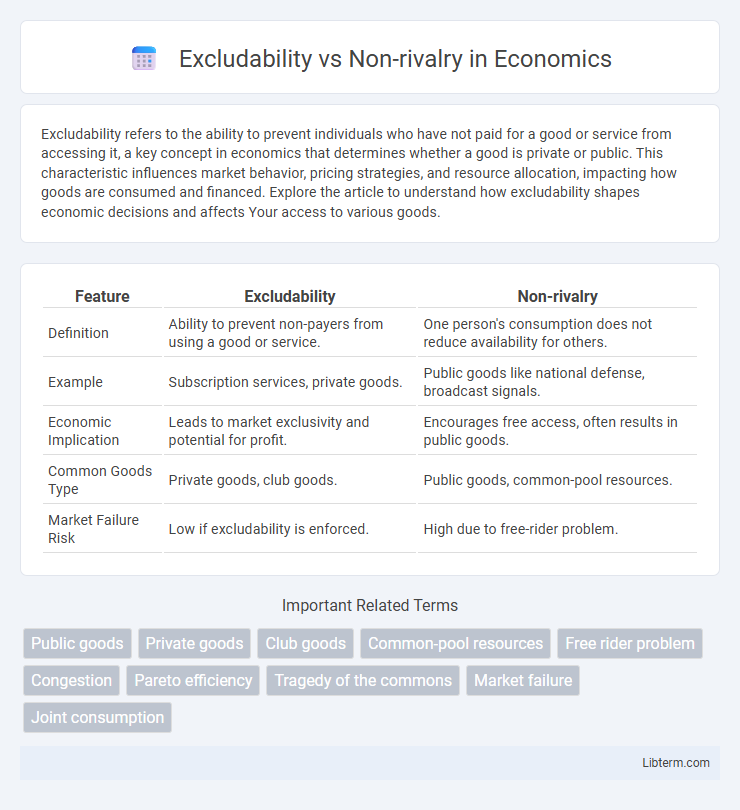Excludability refers to the ability to prevent individuals who have not paid for a good or service from accessing it, a key concept in economics that determines whether a good is private or public. This characteristic influences market behavior, pricing strategies, and resource allocation, impacting how goods are consumed and financed. Explore the article to understand how excludability shapes economic decisions and affects Your access to various goods.
Table of Comparison
| Feature | Excludability | Non-rivalry |
|---|---|---|
| Definition | Ability to prevent non-payers from using a good or service. | One person's consumption does not reduce availability for others. |
| Example | Subscription services, private goods. | Public goods like national defense, broadcast signals. |
| Economic Implication | Leads to market exclusivity and potential for profit. | Encourages free access, often results in public goods. |
| Common Goods Type | Private goods, club goods. | Public goods, common-pool resources. |
| Market Failure Risk | Low if excludability is enforced. | High due to free-rider problem. |
Introduction to Excludability and Non-Rivalry
Excludability refers to the ability to prevent individuals who do not pay for a good or service from accessing it, making it a key factor in determining market efficiency. Non-rivalry occurs when one person's consumption of a good does not diminish its availability to others, commonly seen in public goods like clean air or digital content. Understanding these concepts helps differentiate between private goods, which are excludable and rivalrous, and public goods, which are typically non-excludable and non-rivalrous.
Definitions: Excludability Explained
Excludability refers to the ability to prevent individuals who do not pay for a good or service from accessing or benefiting from it, making it a key characteristic in categorizing economic goods. Goods high in excludability, such as private goods and club goods, allow producers to restrict usage through pricing or legal mechanisms. Understanding excludability helps distinguish between marketable goods and public goods, which often lack this feature and require alternative funding or provision methods.
Understanding Non-Rivalry in Goods
Non-rivalry in goods occurs when one person's consumption does not reduce availability for others, as seen in public goods like national defense or digital content. This characteristic contrasts with rival goods, where consumption by one individual diminishes the quantity or quality available to others. Understanding non-rivalry is essential for efficient resource allocation and policy decisions, especially in managing common goods and public services.
Key Distinctions: Excludability vs Non-Rivalry
Excludability refers to the ability to prevent individuals from accessing a good or service, making it a crucial factor in defining private goods. Non-rivalry occurs when one person's consumption of a good does not reduce its availability for others, a characteristic common in public goods such as clean air or broadcast television. The key distinction is that excludability determines whether consumption can be restricted, while non-rivalry addresses whether consumption impacts others' ability to consume the same good.
Examples of Excludable and Non-Rivalrous Goods
Digital streaming services exemplify excludable and non-rivalrous goods, as access is restricted to paying subscribers while individual consumption does not diminish availability for others. Online software licenses operate similarly, allowing exclusive use without reducing functionality for concurrent users. Subscription-based news websites also fit this category, where content access is controlled, yet one reader's consumption does not limit others'.
The Four Types of Goods: Categorization Matrix
The Four Types of Goods categorization matrix distinguishes goods based on excludability and rivalry: private goods are both excludable and rivalrous, while public goods are non-excludable and non-rivalrous. Common resources are rivalrous but non-excludable, leading to potential overuse, and club goods are excludable but non-rivalrous, allowing shared consumption without depletion. Understanding this matrix is essential for designing policies that address resource allocation and management challenges.
Importance in Public and Private Goods
Excludability determines whether individuals can be prevented from accessing a good, making it crucial for distinguishing private goods, which are excludable and rivalrous, from public goods that lack excludability and are non-rivalrous. Non-rivalry implies that one person's consumption does not reduce availability for others, a key feature of public goods like national defense and clean air, reinforcing their need for government provision or collective funding. Understanding the balance of excludability and non-rivalry informs resource allocation, pricing strategies, and policy interventions to efficiently manage goods and prevent market failures.
Economic Impacts of Excludability and Non-Rivalry
Excludability affects economic efficiency by enabling producers to control access and charge prices, which can lead to market allocation through supply and demand but may also cause exclusion of low-income consumers. Non-rivalry allows for unlimited consumption without diminishing the good's availability, promoting positive externalities and public goods like knowledge and digital content with low marginal costs. Combining non-rivalry with low excludability often results in market failures, necessitating government intervention or alternative funding models to sustain the provision of such goods.
Policy Implications and Market Failures
Excludability and non-rivalry are key concepts influencing public goods and market failures in economic policy. Non-excludable and non-rivalrous goods often lead to free-rider problems, necessitating government intervention to ensure adequate provision and funding. Policymakers must balance exclusion mechanisms and subsidies to address externalities and promote efficient resource allocation in markets exhibiting these characteristics.
Conclusion: Balancing Excludability and Non-Rivalry
Balancing excludability and non-rivalry is essential for effective resource allocation and optimal public goods provision. High excludability limits access, reducing collective benefits, while strong non-rivalry ensures shared consumption without depletion. Policymakers must design mechanisms that moderate exclusivity to enhance equitable access while leveraging non-rival characteristics to maximize social welfare.
Excludability Infographic

 libterm.com
libterm.com